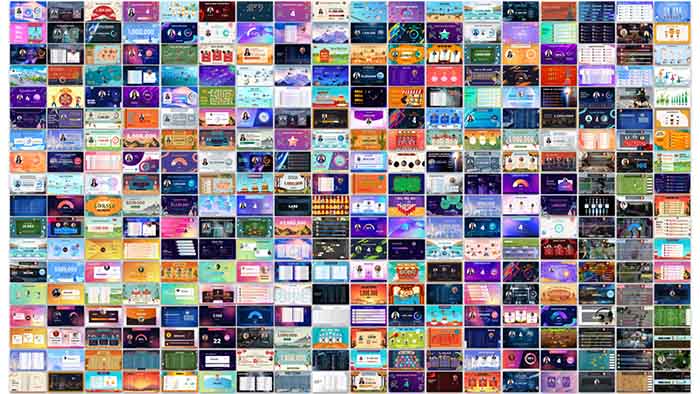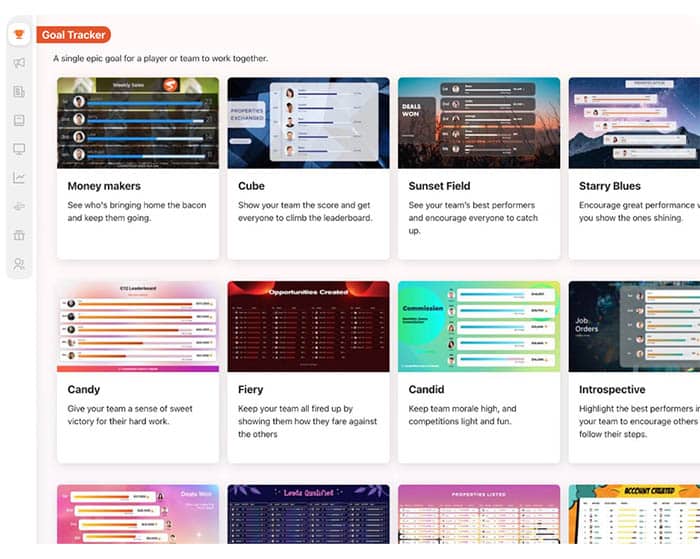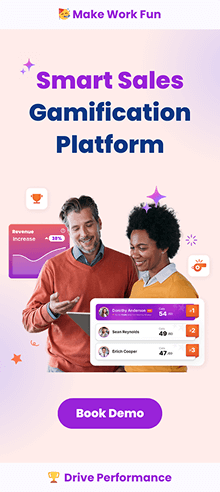What Are Salesforce Reports?
Salesforce, the world’s leading CRM platform, has revolutionized how organizations manage their customer relationships and internal operations. Since its humble beginnings in 1999, Salesforce has grown into a powerhouse that extends far beyond sales automation. Today, businesses of all sizes rely on Salesforce to organize data, streamline processes, and improve decision-making across various functions, from marketing to customer service.
At the heart of Salesforce lies its powerful reporting capabilities. These reports allow organizations to organize vast amounts of data into digestible insights. However, while Salesforce reports are effective in tracking KPIs and performance metrics, their static nature often fails to engage or inspire action among employees. Simply put, reports provide information, but they don’t inherently motivate teams to take action or strive for better results.
This is where leaderboards come in. Transforming Salesforce reports into engaging, dynamic leaderboards can be a game-changer for organizations. By turning raw data into a visual and interactive experience, businesses can inspire competition, drive performance, and foster a sense of achievement within their teams.
Unlock the Power of Salesforce Reports
Salesforce reports are a powerful tool for businesses to gain insights into their sales performance, customer behavior, and market trends. By leveraging Salesforce reports, businesses can make data-driven decisions, optimize their sales strategies, and drive revenue growth. However, with the vast amount of data available, it can be challenging to extract meaningful insights and create actionable reports.
To unlock the power of Salesforce reports, businesses need to focus on creating reports that are relevant, accurate, and actionable. This can be achieved by:
- Defining Clear Business Objectives and KPIs: Start by identifying what you want to achieve. Whether it’s increasing sales, improving customer satisfaction, or identifying market trends, having clear objectives will guide your reporting efforts.
- Identifying the Right Data Sources and Metrics: Not all data is created equal. Focus on the metrics that directly impact your business goals. For example, track metrics like sales activities, opportunity owner performance, and customer purchasing patterns.
- Creating Easy-to-Understand Reports: Use visualizations like charts and graphs to make complex data more digestible. Ensure your reports are straightforward and highlight key insights at a glance.
- Regularly Reviewing and Refining Reports: The business landscape is always changing. Regularly update your reports to ensure they remain relevant and accurate. This continuous improvement will help you stay ahead of the curve.
By unlocking the power of Salesforce reports, businesses can gain a deeper understanding of their sales performance, customer behavior, and market trends, and make data-driven decisions to drive revenue growth and success.
Why Transform Salesforce Reports into Leaderboards?
Leaderboards add an emotional and motivational component to data tracking, making it more than just a numbers game. When team members see their performance visualized in a competitive format, it taps into their natural drive to excel and be recognized. Instead of passively consuming data from a report, employees actively engage with the metrics that matter most to their roles.
Imagine walking into an office and seeing a leaderboard on a large TV screen, highlighting top performers, sales milestones, or the team’s progress toward quarterly goals. This real-time display creates an atmosphere of transparency and accountability, where every team member knows exactly where they stand and what they need to do to improve.

Moreover, leaderboards enhance the usability of Salesforce reports. They break down complex datasets into intuitive visuals that are easy to understand at a glance. Whether it’s a sales manager tracking pipeline velocity or a sales rep striving to meet their monthly quota, leaderboards make it easier to connect data to actionable outcomes.
Designing Effective Leaderboards
Leaderboards are a powerful tool for motivating sales teams and driving business results. However, designing an effective leaderboard requires careful consideration of several key factors. Here are some tips for designing effective leaderboards:
- Define Clear Goals and Objectives: The leaderboard should be aligned with the business’s overall goals and objectives. Whether it’s boosting sales, improving customer service, or enhancing team collaboration, clarity in purpose is crucial.
- Choose the Right Metrics: The metrics used to track performance should be relevant, accurate, and actionable. Focus on metrics that directly impact your business results, such as deals closed, revenue generated, or customer satisfaction scores.
- Make It Visual: The leaderboard should be easy to understand and visualize, with clear and concise language and graphics. Use colors, progress bars, and rankings to make the data engaging and easy to interpret.
- Make It Competitive: The leaderboard should be designed to foster competition and motivation among team members. Highlight top performers and create a sense of urgency with time-bound challenges.
- Make It Fair: The leaderboard should be fair and unbiased, with clear rules and criteria for ranking. Ensure that all team members have an equal opportunity to succeed and that the metrics used are within their control.
By designing effective leaderboards, businesses can motivate their sales teams, drive business results, and achieve their goals.
Step-by-Step Guide: Transforming Salesforce Data into Leaderboards
1. Start with Meaningful Salesforce Reports
Before you can create an effective leaderboard, you need to identify the metrics that matter most to your company. Start by assessing your Salesforce reports to ensure they align with your team’s goals. Whether it’s tracking closed deals, converted leads, or revenue generated, your reports should focus on KPIs that drive business outcomes and employee performance.
To create these reports, navigate to the Salesforce Reports tab and select the relevant data sets. Customize the filters, groupings, and visualizations to highlight key metrics. For example, if you’re tracking monthly sales performance, include fields like total revenue, number of deals closed, and sales target percentages.
2. Choose a Gamification Platform
Integrating a gamification platform like Spinify can simplify the process of transforming Salesforce reports into leaderboards. Spinify’s app is available on the Salesforce AppExchange, making it easy to install and integrate directly into your CRM. Once installed, the Spinify app allows you to manage leaderboards, competitions, and celebrations without leaving Salesforce.
Spinify is designed to make the setup process effortless. It includes pre-built templates for leaderboards and competitions, so you don’t have to start from scratch. Whether you’re launching a leaderboard to track individual sales performance or team-based KPIs, Spinify’s intuitive interface guides you through every step.
3. Set Up Your First Leaderboard
Once you’ve chosen your gamification platform, it’s time to set up your first leaderboard. Spinify offers a range of customization options, allowing you to tailor leaderboards to your organization’s specific needs. Start by defining the goals and metrics you want to track and from there select the type of competitions that fits your goals. For example, you can create a leaderboard that ranks sales reps based on deals closed in the current quarter.
Spinify also allows you to set up milestones and celebrations for when employees reach their targets. This adds an element of fun and recognition to the experience, boosting motivation and morale.
4. Display Leaderboards on Office TVs or Dashboards
Visibility is key to the success of any leaderboard. By displaying leaderboards on office TVs or digital dashboards, you ensure that performance metrics are front and center for your team. Spinify’s integration with Salesforce enables real-time updates, so the leaderboard reflects the latest data without any manual intervention.
Customize the visuals to make your leaderboards easy to read and engaging. Use clear fonts, contrasting colors, and progress bars to highlight key information. For larger teams, consider creating rotating leaderboards that scroll through all participants, ensuring everyone gets visibility.
5. Add Automatic Celebrations
One of Spinify’s standout features is its ability to celebrate achievements automatically. When an employee hits a milestone or closes a big deal, the leaderboard can display a personalized celebration message, complete with confetti animations or music. These small moments of recognition can have a big impact on morale and motivation.

By automating celebrations, you also create a consistent culture of recognition. Employees feel valued for their contributions, which can lead to higher engagement and job satisfaction.
What Should a Sales Gamification Platform Offer?
A robust sales gamification platform is more than just a way to visualize data—it’s a strategic tool designed to boost company performance, drive team engagement, and foster a culture of achievement. To achieve these outcomes, a gamification platform must go beyond basic metrics and provide features that truly resonate with your team. Here’s what to look for in an effective platform:
1. Dynamic Leaderboards
A great gamification platform offers leaderboards that reflect real-time updates. These should be dynamic, showing each participant’s rank based on their performance metrics. Real-time tracking ensures that every action taken by the team is instantly reflected, keeping the competition fresh, exciting, and motivating.
2. Variety in Competitions and Leaderboard Designs
A strong sales gamification platform offers diverse competition types, such as individual challenges, team-based contests, and time-sensitive sprints, to keep teams motivated and aligned with goals. These formats foster healthy competition and collaboration, driving engagement and performance while keeping the experience fresh and dynamic.
Equally important are engaging leaderboard designs that clearly display performance metrics. With over 300 designs and flexible competition formats, Spinify transforms data tracking into a motivating and results-driven experience.

3. Visual Progress Indicators
Progress bars are an essential feature for any gamification tool, allowing participants to see how close they are to achieving their goals. A clear visualization of individual and team progress provides immediate feedback, making it easier for employees to adjust their efforts and stay motivated.
4. Time-Bound Challenges
Adding countdowns or deadlines to competitions creates a sense of urgency, driving faster action and focus. Platforms that incorporate time-based elements make it easier to tie gamification to specific business goals or time-sensitive campaigns.
5. Milestone Celebrations and Notifications
Customizable notifications and celebrations are vital for keeping teams engaged. The best platforms highlight major milestones such as “Top Performer of the Week” or significant achievements like closing a large deal. Automatic celebration features, add an element of fun and recognition that fosters a positive team culture.
6. Customization and Scalability
Every organization has unique goals, so a gamification platform must be customizable to match your KPIs and team structure. Spinify excels here, offering fully configurable leaderboards and achievements that can scale with your business needs.
Why Choose Spinify?
Spinify isn’t just a gamification platform—it’s a comprehensive solution for transforming workplace engagement and performance. Spinify ensures you can find the perfect gamification strategy for your team. The variety of competitions keeps the experience fresh, and the intuitive setup process means you can get started in minutes. Whether you’re looking to motivate individuals, boost team collaboration, or achieve specific sales goals, Spinify has the tools to make it happen.

By choosing Spinify, you’re empowering your team with a platform that doesn’t just track performance but actively drives it. Unlock the full potential of your Salesforce data with engaging, motivational tools that inspire your workforce every day.
Spinify: Elevate Salesforce Leaderboards to the Next Level
Spinify takes the guesswork out of gamification with its seamless integration and robust feature set. Here’s how Spinify enhances your Salesforce experience:
- Instant Integration: Get up and running in minutes with Spinify’s effortless setup process.
- Pre-Built Competitions: Access a library of ready-to-use competitions and leaderboards that are compatible with popular Salesforce metrics.
- Real-Time Updates: Spinify automatically syncs with Salesforce, ensuring that your leaderboards are always up-to-date.
- Detailed Analytics: Analyze performance trends and competition outcomes to identify areas for improvement and celebrate successes.
With Spinify, you’re not just tracking performance—you’re transforming it. The platform turns static Salesforce reports into dynamic leaderboards that inspire action and drive results.
Measuring Success and ROI
Measuring the success and return on investment (ROI) of leaderboards is critical to ensuring they remain effective and relevant. Here are some tips for measuring success and ROI:
- Define Clear Metrics: The metrics used to measure success and ROI should be clear, concise, and relevant. Focus on key performance indicators that align with your business goals, such as sales growth, customer acquisition, or employee engagement.
- Track Progress: Regularly track and monitor the progress of the leaderboard. Use clear and concise language and graphics to display performance metrics and trends.
- Analyze Data: Regularly analyze the data from the leaderboard to identify trends, patterns, and areas for improvement. Look for insights that can help you refine your strategies and drive better results.
- Adjust and Refine: Continuously adjust and refine the leaderboard to ensure it remains relevant and effective. Update metrics, goals, and visualizations as needed to keep the competition fresh and engaging.
- Evaluate ROI: Regularly evaluate the ROI of the leaderboard to ensure it remains a valuable investment for the business. Consider factors like increased sales, improved team performance, and higher employee engagement.
By measuring success and ROI, businesses can ensure their leaderboards remain effective and relevant, and drive business results and revenue growth.
Results You Can See and Feel
The impact of leaderboards extends beyond the individual metrics they display. By transforming Salesforce reports into engaging visualizations, organizations can achieve:
- Higher CRM Adoption Rates: Employees are more likely to use Salesforce when it’s gamified and interactive.
- Improved Productivity: Friendly competition motivates teams to work harder and achieve their goals.
- Greater Transparency: Leaderboards provide a clear view of individual and team performance, fostering accountability and collaboration.
Ready to Transform Your Salesforce Experience?
Spinify makes it easy to turn raw Salesforce data into powerful, motivational tools. Whether you’re looking to boost CRM adoption, improve team performance, or celebrate employee achievements, Spinify has you covered.
For more insights, explore “11 Tips to Make Salesforce Kickass” or dive into our Guide to Gamify Salesforce and Adoption. Don’t wait—install Spinify from the Salesforce AppExchange today and take the first step toward a more engaged and motivated workforce. Book you demo today to see Spinify in action.



